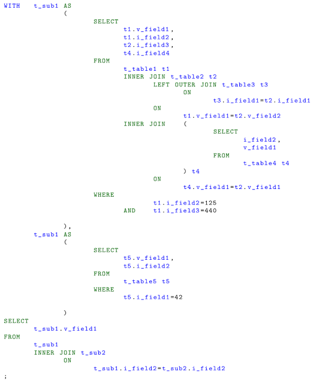Nuts and Bolts - part 2
WITH statements
Because the WITH statement works like having a temporary table, the formatting will follow rules similar to the CREATE TABLE statement.
• Between the WITH and the alias there is a tab followed by the word AS
and a carriage return
• The round brackets surrounding the inner query indent one tab from the
alias
• The inner query indents one tab from the round brackets
Conclusions
This coding style is at first sight complex and with some drawback as it can slow down the coding process because of more keystrokes required for the uppercase and the carriage return. However, when the writing automatism is acquired the coding speed is very fast.
This coding style creates the query using a top down structure where the different part of the query are indented in order to reflecting their level inside the query’s logic. This increases the query readability in particular when dealing with complex queries.
The vertical block structure gives great control on the query’s sub sections. With query editors supporting the partial code execution (e.g. pgadmin3’s query ) is possible to highlight the query’s single sections and execute them immediately.
I developed this style from the induction I received in my first DBA job. My employer enforced along the developers and DBA a similar set of rules which worked perfectly, improving the produc- tivity and the code’s consistency across the company.
Incidentally this matches almost perfectly the way PostgreSQL processes a select. What follow is an excerpt of the PostgreSQL’ manual describing how the select is processed.
SELECT
retrieves rows from zero or more tables.
The
general processing of SELECT is as follows:
- All queries in the WITH list are computed.
These effectively serve as temporary tables that can be referenced in the FROM list.
A WITH query that is referenced more than once in FROM is computed only once.
2. All elements in the FROM list are computed.
(Each element in the FROM list is a real or virtual table.)
If more than one element is specified in the FROM list, they are cross-joined together.
3. If the WHERE clause is specified, all rows that do not satisfy the condition
are eliminated from the output.
4. If the GROUP BY clause is specified, or if there are aggregate function calls,
the output is combined into groups of rows that match on one or more values,
and the results of aggregate functions are computed.
If the HAVING clause is present, it eliminates groups that do not satisfy the
given condition.
5. The actual output rows are computed using the SELECT output expressions
for each selected row or row group.
6. SELECT DISTINCT eliminates duplicate rows from the result.
SELECT DISTINCT ON eliminates rows that match on all the specified expressions.
SELECT ALL (the default) will return all candidate rows, including duplicates.
7.
Using the operators UNION, INTERSECT, and EXCEPT, the output of more
than one
SELECT statement can be combined to form a single result set.
The UNION operator returns all rows that are in one or both of the
result sets.
The INTERSECT operator returns all rows that are strictly in both result
sets.
The EXCEPT operator returns the rows that are in the first result set
but not in the second.
In all three cases, duplicate rows are eliminated unless ALL is
specified.
The noise word DISTINCT can be added to explicitly specify eliminating
duplicate rows.
Notice that DISTINCT is the default behavior here, even though ALL is
the default for SELECT itself.
8.
If the ORDER BY clause is specified, the returned rows are sorted in the
specified order.
If ORDER BY is not given, the rows are returned in whatever order the
system finds fastest to produce.
9.
If the LIMIT (or FETCH FIRST) or OFFSET clause is specified, the SELECT
statement only returns
a subset of the result rows.
10. If
FOR UPDATE, FOR NO KEY UPDATE, FOR SHARE or FOR KEY SHARE is
specified,
the SELECT statement locks the selected rows against concurrent
updates.


